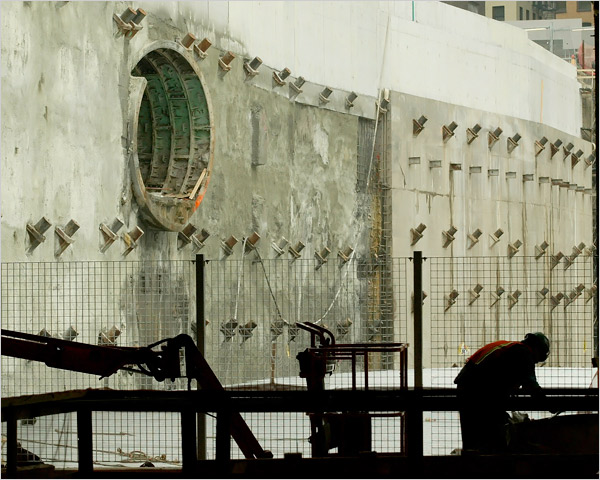The immersive sculpture of linked voids
When you pull back the curtain of Manhattan, what do you find?
 [Image: Photo by Andrea Mohin for The New York Times].
[Image: Photo by Andrea Mohin for The New York Times].
The so-called "birthmark of the World Trade Center" has been removed from the earth of New York City. These "colossal cast-iron rings," as The New York Times describes them, were "the last visible remnant of the Hudson & Manhattan Railroad" that once crossed through the World Trade Center site.
In an excavatory act that would seem to combine the best conceptual aspects of Rachel Whiteread, Michael Heizer, and Gordon Matta-Clark, what was once a tunnel – an underground space of air – has been strangely inverted, transformed into an object, freed from its terrestrial context.
Perhaps leading to the question: What if Michael Heizer had retired altogether from the art world – only to get a job, under an assumed name, as an engineer on the New York City subway system? What strange resonances might that mobile underworld now take?
An immersive sculpture of linked voids beneath the city.
 [Image: Photo by Fred R. Conrad for The New York Times].
[Image: Photo by Fred R. Conrad for The New York Times].
Meanwhile, as the construction work at Ground Zero continues, the whole site has become a massive archaeological site, exposing an earlier phase of planetary history.
Also from The New York Times:
Ground Zero has thus become a kind of horizontal stargate, a terrestrial windowpane pulled wider and wider in the landscape of Lower Manhattan.
 [Image: Photo by David W. Dunlap for The New York Times].
[Image: Photo by David W. Dunlap for The New York Times].
In any case, what about those colossal cast-iron rings? Now that they've been pulled from the earth, they've been warehoused: "These have been taken to Hangar 17 at Kennedy International Airport, where large-scale trade center artifacts are stored."
But might I suggest that they be shipped upstate to Dia:Beacon, instead?
 [Image: Photo by Andrea Mohin for The New York Times].
[Image: Photo by Andrea Mohin for The New York Times].The so-called "birthmark of the World Trade Center" has been removed from the earth of New York City. These "colossal cast-iron rings," as The New York Times describes them, were "the last visible remnant of the Hudson & Manhattan Railroad" that once crossed through the World Trade Center site.
In an excavatory act that would seem to combine the best conceptual aspects of Rachel Whiteread, Michael Heizer, and Gordon Matta-Clark, what was once a tunnel – an underground space of air – has been strangely inverted, transformed into an object, freed from its terrestrial context.
Perhaps leading to the question: What if Michael Heizer had retired altogether from the art world – only to get a job, under an assumed name, as an engineer on the New York City subway system? What strange resonances might that mobile underworld now take?
An immersive sculpture of linked voids beneath the city.
 [Image: Photo by Fred R. Conrad for The New York Times].
[Image: Photo by Fred R. Conrad for The New York Times].Meanwhile, as the construction work at Ground Zero continues, the whole site has become a massive archaeological site, exposing an earlier phase of planetary history.
Also from The New York Times:
- A fantastic landscape in Lower Manhattan – plummeting holes, steep cliffsides and soft billows of steel-gray bedrock, punctuated by thousands of beach-smooth cobblestones in a muted rainbow of reds and purples and greens – has basked in sunlight this summer for the first time in millennia.
This monumental carving was the work of glaciers, which made their last retreat from these parts about 20,000 years ago, leaving profound gouges in the earth and rocks from the Palisades, the Ramapo Mountains and an area of northern New Jersey known as the Newark Basin.
Plumbing these glacial features and souvenirs has been critical in preparing the foundation for Tower 4 of the new World Trade Center, being built by Silverstein Properties. The concrete footings from which its columns rise must rest on firm bedrock. Engineers need a clear understanding of the rock’s contours.
Ground Zero has thus become a kind of horizontal stargate, a terrestrial windowpane pulled wider and wider in the landscape of Lower Manhattan.
 [Image: Photo by David W. Dunlap for The New York Times].
[Image: Photo by David W. Dunlap for The New York Times].In any case, what about those colossal cast-iron rings? Now that they've been pulled from the earth, they've been warehoused: "These have been taken to Hangar 17 at Kennedy International Airport, where large-scale trade center artifacts are stored."
But might I suggest that they be shipped upstate to Dia:Beacon, instead?





Comments are moderated.
If it's not spam, it will appear here shortly!
I would love to see that guy who made those awesome plaster casts of ant dens do the same thing for cities.
the towers fell in ten seconds. that is the same as a billiard ball in a vacuum from the same height.... that suggests something. i think
A quite cool (imho) tool to discover what's beyond a given location (in terms of stratigraphy) by 'web-intelligence' is Stratigraphy.net's agesearch utility.
It's a bit hard to explain.. if you have some time for playing just follow the example search for New York..
Post a Comment